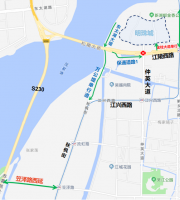Scaffolding refers to the temporary structural framework used for loading, stacking, and construction operations during construction. External scaffolding, in general, should not only have the general functions of scaffolding, but also have safety protection and aesthetic functions..
1. According to the bearing form of external scaffolding foundation, it can be divided into: floor standing scaffolding and cantilever scaffolding;.
2. According to the number of upright columns of external scaffolding, it can be divided into double row scaffolding and single row scaffolding;.
3. According to the degree of closure of external scaffolding, it can be divided into open scaffolding, partially closed scaffolding, semi closed scaffolding, and fully closed scaffolding;.
4. According to whether the external scaffolding intersects around the perimeter of the building, it can be divided into open type scaffolding and enclosed type scaffolding..
Floor standing scaffolding: Floor standing steel pipe scaffolding refers to single or double row fastener type steel pipe scaffolding erected from the ground or building structure facing upwards..
Overhang scaffolding: Overhang scaffolding is a construction external scaffold composed of a combination of steel support frame (or fastener type steel pipe), fastener type steel pipe scaffolding, and connecting wall components. Its vertical load is transmitted to the main structure through the bottom steel support frame (or fastener type steel pipe)..
Double row scaffold: A scaffold composed of two rows of vertical and horizontal poles, both inside and outside..
Single row scaffold: a scaffold with only one row of upright poles and one end of the horizontal pole resting on the wall..
Open scaffold: a scaffold equipped only with work level railings and toe boards, without any other covering facilities..
Partial enclosed scaffolding: scaffolding with a coverage area of less than 30%..
Semi enclosed scaffolding: scaffolding with a coverage area of 30% to 70%..
Fully enclosed scaffold: A scaffold that is enclosed along the entire length and height of the outer side of the scaffold..
Open scaffold: A scaffold set up along the perimeter of a building that is not closed..
Closed loop scaffold: a scaffold set up in a closed manner along the perimeter of a building..
Before the construction of external scaffolding, it is necessary to conduct on-site survey, discussion, and determine the design plan..
The principle of designing external scaffolding is to choose the form of scaffolding based on the characteristics of the engineering form, the height of the project, the requirements for the function of external scaffolding, and relevant specifications and regulations for external scaffolding..
The choice of form of external scaffolding, whether it is double row scaffolding or single row scaffolding, floor standing scaffolding or cantilever scaffolding, open scaffolding or closed scaffolding, etc., should be determined based on the characteristics of the building, national or local standards and regulations, and the functional requirements of the scaffolding..
For example, the Safety Technical Specification for Construction Coupler type Steel Pipe Scaffolding stipulates that single row scaffolding is not applicable to the following situations:.
1) Wall thickness less than or equal to 180mm;.
2) The height of the building exceeds 24m;.
3) Lightweight walls such as hollow brick walls and aerated block walls;.
4) Brick walls with mortar strength grade less than or equal to M1.0..
Therefore, when a building meets one of the four conditions mentioned above, the design scheme for a single row of scaffolding is not considered..
In addition, according to convention, when the height of scaffolding exceeds 50 meters, it is not advisable to use floor standing scaffolding. It should be suspended or appropriately unloaded according to the situation..
In order to meet the requirements of safety protection and beautification of construction sites around buildings, fully enclosed scaffolding is usually used.



